
On 10th November 2018 a large landslide took place above the eastern end of Loch Quoich. It was triggered by the collapse of a crag halfway up the steep hillside, demolished an electricity pylon and resulted in the road to Kinloch Hourn being closed for 6 months while the slope was stabilised at an estimated cost of £1m.
An informative commentary on the causes of the landslide and links to photos/drone footage of original damage can be found on Dave Petley’s Landslide Blog which covers major landslides round the world (see here). I didn’t visit the site until last month but believe what happened and the subsequent restoration has direct implications for both our National Parks.
High risk slopes
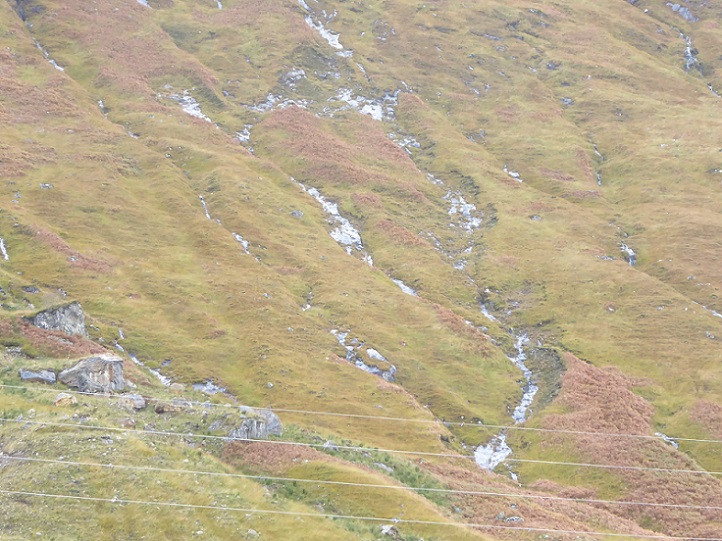
Falling rocks/collapsing crags clearly have a significant impact on the slopes that lie below them and in this case triggered a wider landslide (estimated 9,000 tonnes). That is not always the case, as is illustrated by the rockfalls above the Radical Road in Edinburgh (see here). The risk of landslides is determined by topography, climate and climate change but also how we use the land.
The state of the ground to the right of the landslide at Loch Quoich, a skin of glacial debris and earth lying on top of glacial slabs without a tree or shrub in sight, suggests that this whole slope was/is waiting to go. You can see how water has scoured away the slopes to leave areas of bare rock. Whatever the stability of the crag which partially collapsed, it’s not difficult to see how major rainfall might trigger further landslides here. And the western end of Loch Quoich is one of the wettest places in Scotland………….
The parallels with the land above the A83 below the Rest and Be Thankful in the Loch Lomond and Trossachs National Park should be obvious.
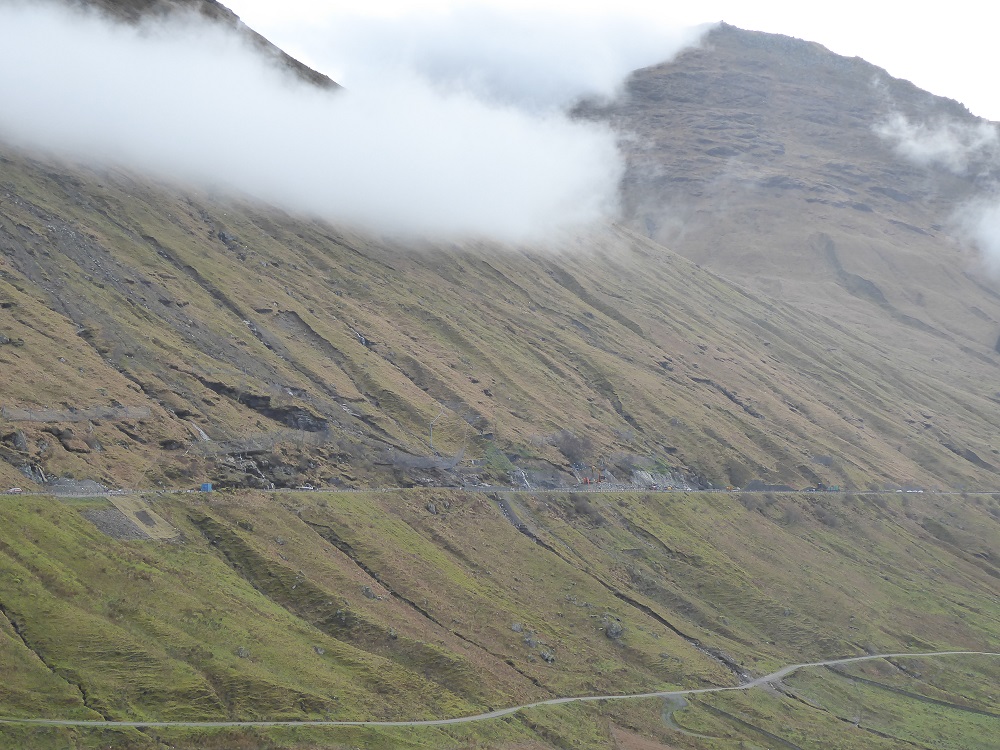
The skin of glacial debris and soils at the Rest and Be Thankful appears to be thicker than at Loch Quoich. Potentially that might have made it easier for trees to establish themselves on this slope and help stabilise it.
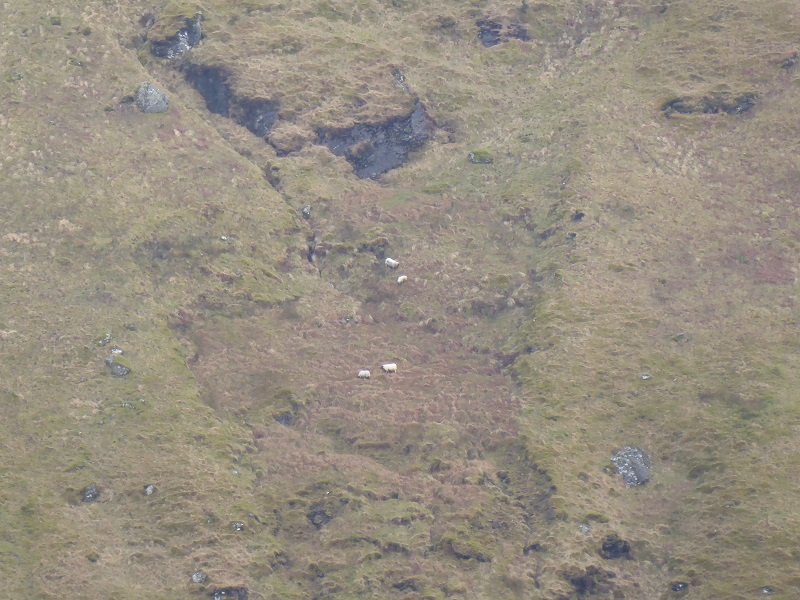
But despite the known risks, sheep were still being allowed to graze these slopes two and a half years ago, just like deer at Loch Quoich where the Deer Management Group reports an average density of 15 deer per square kilometre (see here for figures in Deer Management Plan)
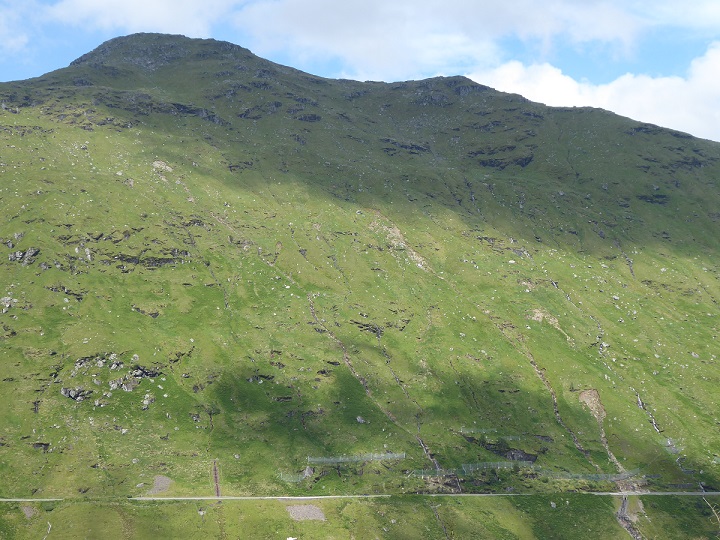
The greater depth of debris and soil at the Rest and Be Thankful has meant that once the slope reached tipping point, it has become even more difficult to stabilise through engineering works. Loch Quoich shows that the problems at the Rest and Be Thankful are far from unique.

With the increase in extreme rain events due to climate change, closure of roads and disruption of utilities is likely to become more common. While sometimes it seems the Scottish Government has a policy and strategy for almost everything, it doesn’t have one for landslips. It should do but that would mean tackling the predominant forms of land-use in the uplands (industrial forestry, sheep farming and sporting estates) and the environmental degradation they have caused.
It would also mean the Scottish Government would have to stop palming off responsibility for fixing the problems caused by climate change and land-mismanagement, including landslips, onto others: Highland councillors were apparently forced to meet the costs of stabilising the slopes above Loch Quoich “from other capital budgets” even though the council could have done nothing to prevent this landslip.
Highland Council have not been helped by the Loch Lomond and Trossachs National Park Authority (LLTNPA) failing to show a lead. The LLTNPA has failed to consider the landslide problem in the National Park and has been almost totally silent about the problems at the Rest and Be Thankful. They are therefore in my view in part responsible for the road closures at the Rest and Be Thankful which are becoming more frequent (see here) as Transport Scotland rightly has to close the main A83 whenever heavy rain is forecast.
The catch pits at the Rest and Be Thankful – a lesson from Loch Quoich
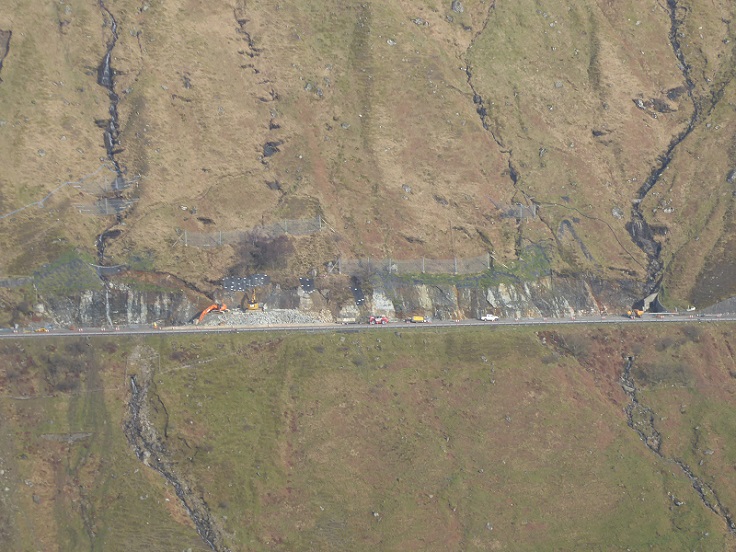
Rather than address the issues created by the construction of A83 across a steep slope that was always high risk and has been allowed to become even more unstable through decades of land mis-management, the Scottish Government’s answer has been to put up fences and dig holes above the road in the hope of catching debris. It hasn’t worked but despite that in September the Scottish Government committed another £3.5m to constructing yet more catchpits. That the Rest and Be Thankful Campaign were right to be criticise the decision (see here) is demonstrated by what happened at Loch Quoich.
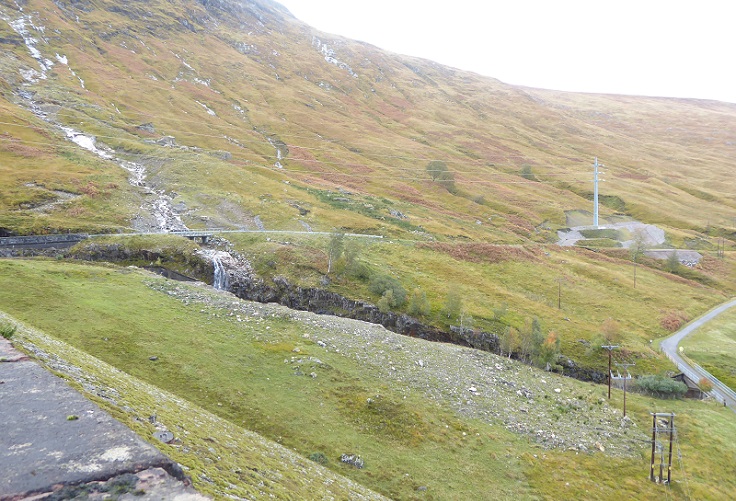
A significant part of the landslide jumped the spillway – have you ever seen a larger catchpit?.
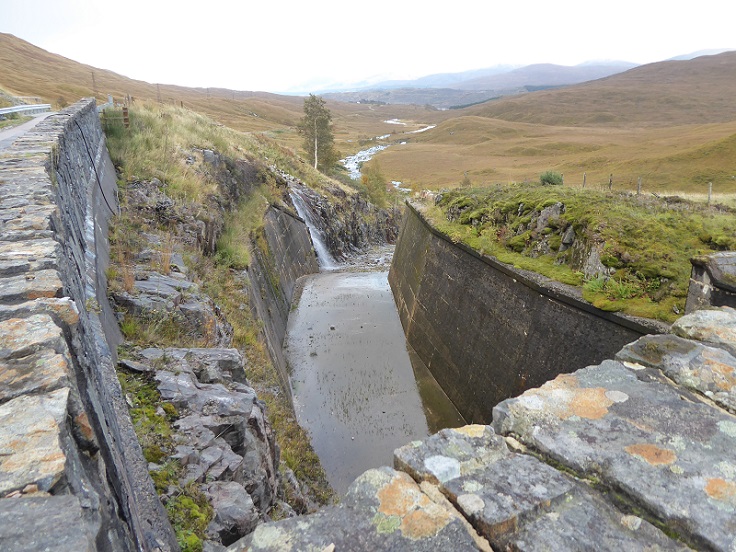
An impressive leap! I haven’t been able to find out how much material dropped into the spillway but apparently the hydro electricity operation at the dam was closed until it was cleared – so some did. Clearly, to cross his gap the landslide must have been moving at a significant velocity and the change in angle when it hit the road above may have helped it become airborne. . While the catch pits at the Rest and Be Thankful are 6m deep, at least one of the crags above (visible in the photos) appears well placed to serve as a landslide spring board, so it is not just their capacity which is the issue.
There are similar unstable slopes on both sides of the Rest and Be Thankful, which will take decades to address with any nature-based solutions. Given the landscape importance of Glen Croe and the importance of the A83, the LLTNPA should have been advocating for work to start on a tunnel as soon as possible. Instead, so far, they have chosen to remain silent.
Scottish and Southern Electricity’s environment credentials

Yesterday, my copy of the Herald was wrapped in a cover paid for by SSE, which described itself as “Principal Partner for COP 26”. There are actually eleven (see here).
Inside there is a piece from Nicola Sturgeon, which says “it is important to keep on investing in sustainable projects that deliver both environmental and economic benefits for Scotland”. Alongside that there is a piece from Alistair Phillips-Davies, Chief Executive of SSE, which talks about “constructing smarter greener electricity highways in our transmission and distribution businesses”.
The three electricity pylons that SSE have replaced at Loch Quoich give a glimpse of what this “greener transmission system” means on the ground.

Large quantities of imported aggregate – at what carbon cost – more hardstanding to drain water off the hill and no attempt at landscape restoration.
The hyprocrisy at the top of SSE is remarkable. On the one hand they take money from government to underground pylons and restore the landscape in places like Glen Falloch (see here), while elsewhere they show no compunction in trashing the natural environment. This is not the fault of people who are doing the work on the ground, they do what they are told, but it is the consequence of capitalist companies like SSE that put money before people and the natural environment.
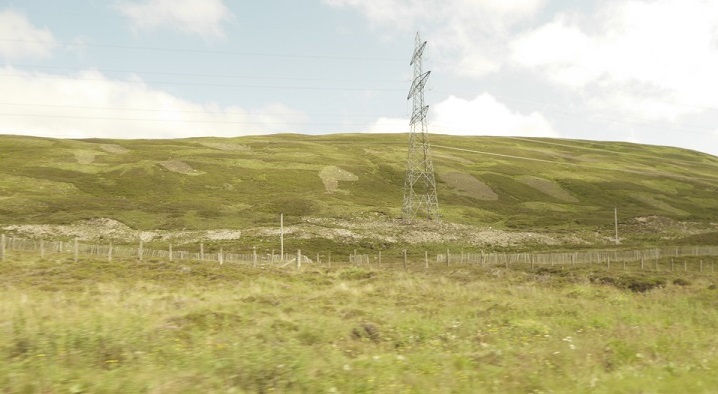
After seeing what SSE’s subsidiary, Scottish and Southern Electricity Network, have done at Loch Quoich, my appreciation of the actions and challenges that the Cairngorms National Park Authority (CNPA) have faced at Drumochter (see here) has increased. It took courage for their Board to oppose SSE’s plans for the Beauly Denny. And, after they were overruled and the powerline went ahead, it’s scarcely surprising that a company that took no care at Quoich, took such little care at the Drumochter. To companies like SSE protected sites like the Drumochter are just an annoying distraction and our National Park Authorities, even where they have the will, do not have the power to challenge this.
Alistair Philips-Davies talks in his piece about “putting our money where our mouth is”. Those claims, like those of many of the big companies attending COP 26, are best described as “green mouth wash”.

how many times will the lessons not be learned?
You must despair Ron – given what you have been going on about for decades and decades. Still, nice to hear from you
A drive around the highlands after the floods of 2014 and looking at the damage was revealing and should have awakened the authorities to the dangers but awareness seems limited. For years, I drove over the Sloch on the A9 looking at the grossly overburned and overgrazed slopes and wondering, “I wonder when that lot is going to go?” Then it did after one real downpour and there were wide exclamations of surprise! Adam Watson and I were shown round slope stabilisation works on the Swiss Alps. The main guy overseeing this wrote a textbook in German on it and the Canadians grabbed it and translated it into English – but I don’t know if much use has been made of it in Scotland. In the Alps, planting and managing trees is a major measure in slope stabilisation. I worked for the Environment Agency in the Lake District many years ago training them in public consultation etc. The guy who employed me had spearhead a project under which all the slopes in the Lake District that were surveyed and all those graded as potentially unstable were planted up – all with a grant from the Lottery. With increase in the frequency and severity of extreme events with climate change, this problem will get worse.
I didn’t know the Lake District National Park Authority had surveyed all the slopes in the Lake District, that is exactly what we need the Loch Lomond and Trossachs and Cairngorms National Park Authorities to do and perhaps NatureScot, who are formally responsible for overseeing deer numbers in the rest of the country, should do this elsewhere
Aye, Drennan, I remember your various talks over the years and that famous shot of the ‘decapitated’ house below the deforested hill, while the houses below the forested sections were unaffected by the avalanche. The lessons have been cogently and deliberately ignored.
I well remember 31st July 2002 when the localised rain storm hit the Slochd. Rocks from the A9 road cutting blocked a culvert and forced water onto the carriageway at Slochd Mor and the road kerbs channelled water south to a low point. Here it spilled down onto the old A9. The slope below was in fact well wooded, but it collapsed under this additional load. Whilst the surrounding slopes are burnt and grazed – the railway was built in 1893 and decades of steam train fires added to the burden as old photos show. The problem in 2002 was poor engineering (cutting is now netted) and maintenance rather than slope instability. It is worth noting nearby a small burn hit by the same storm saw major channel failure and bridge collapse on the flood plain with no slopes involved and was primarily due to the estate placing a new track right beside the burn a few months earlier. The water just cut down the track and removed the bank in between joining it up with the burn channel. The result was a massive bare gravel wash out plain and debris under the bridge. Interestingly despite some limited grazing stripping the soil appears to have created excellent recolonisation opportunities and the gravel beds are now thick with 10 -20 ft alder trees. Unscientific annual trips to the Austrian Alps with occasional Swiss forays over the last 20 years shows eroding steep wooded slopes in many locations – I had this down to orogeny in dynamic landscapes – something they had mostly learned to live with.
If anyone is not yet convinced about the need for planting to stabilise slopes, they have only to travel to the west coasts and highlands of Scotland . Here wind blown seeds have led to huge “stands” of the invasive species Rhododendron Ponticum. This blanket cover now cloaks ( and of course stabilises) too many lower slopes. The pest which escaped from areas tended as Victorian era gardens and parklands, spreads on the wind,both by seed and by regenerating tuber. It is unpalatable to grazing animals. To begin with animals will eat any alternative seedlings that appear among seedling of the pest , until the ponticum overshadows all competitor. As it grows the ponticum gradually acts to acidify and poison the ground beneath it. Even when cleared by cutting and burning, no other ground cover will regenerate for many decades.
The success of these unpalatable plants – the way Ponticum seedlings under no grazing pressure can now be found rapidly spreading outwards across peat bogs and other open ground – points to another urgency.
One message is clear: replanting on west facing steep slopes will now have to be managed, (as in Switzerland). With out control , with the spread of ponticum ravaging underused hillsides to the west, these stands are upwind. It is already far too late to “leave it to nature” . Too late to simply remove grazing pressure and let natural selection of dormant vegetation repopulate Scotland’s bare hillsides in any uncontrolled way. .
Nick. I could not agree more. I assessed an SSE overhead line scheme in Argyll many years ago for new pylon routes and it took considerable effort to get them to choose better options. The Highlands with many roads and railways crossing steep slopes are very sensitive to development, affecting the ecology and topography in many ways. We should learn from poorly designed short term options but the cost benefit analysis does not take into account maintenance costs and ecological impacts. We are having similar issues on the A9 dualling!
It is not rocket science. Ron Greer and I gave a presentation at Holyrood regarding the Rest and be Thankful, I think it was 2015. Pointed out the “bleedin obvious” and proscribed a planting cocktail to stabilise the slope based on evidence from Scotland, North America and Norway with data to back up our position. Government Minister was amazingly open minded and supportive. Further down the line however, institutional inertia and bias resulting in straightforward procrastination and blocking (FC – an acronym as opposed to two letters missing). Our problem is not the lack of knowledge of what to do to resolve these situations, it is the institutional inertia of organisations who, on paper, have the remit to deliver but obfuscate to maintain their political system control over the issue.
Remember, when you create an organisation the first thing it gets is a survival mechanism; at the level of the individual, they want to keep their jobs; at the level of the institution, it wants to keep it power and political position. The platforms of free and open thinking where ideas are exchanged as opposed to positions being defended, are not for them. Right, now let’s talk about the effect of landowners and lack of local control …
Sheep should be removed from all wild uplands and located in lowland fields only. The only exceptions could be locations where we don’t want trees to grow. The ecological impact is huge, yet the benefit to the country is tiny as there is no profit in hillfarmed sheep. Get them off the hills and wild areas.
Nick this was discussed by CNPA 10 -15 years ago in the Cairngorms, particularly for key infrastructure – road and rail at entry point at Drumochter, Slochd Mor, Lecht, and Cairnwell but like many other issues in the CNP these responsibilities and the legislation governing them lie primarily with other public bodies at regional, national and in the case of Network Rail at UK level. The issue of adjacent landownership is also a key factor as is allocation of park authority resources and priorities. Partha Dasgupta makes an interesting point about how transport routes through nature have accumulated human wealth whilst decumulating natural capital. Valuing ecosystem service can be done and payment maybe required. Funding tree planting with lottery grants or squeezing small Park authority budgets seems to me to be unwise.
Interesting pic here clearly showing the debris run over the spillway.
https://www.mountaineering.scot/assets/contentimages/WP12-15960-20181210152943.jpeg